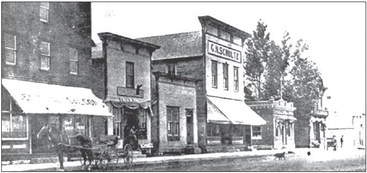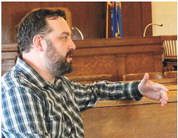May 1 marks 100 years since “The Big Fire” in Dorchester


One of the significant hazards for people living in the early 20th century was fire. Structures were primarily wood and combined with oil lanterns and wood stoves, and fires could quickly occur Most of us can readily recall learning in school about the famous Chicago Fire and Peshtigo Fire, both occurring in October 1871. However, few people today know that on May 1, 1923, Dorchester experienced what the locals called “The Big Fire.”
At the time of “The Big Fire,” Dorchester was a village of around 468 people. May 1, 1923, most likely began like any other day for the people of Dorchester. Children went to school and workers headed off to their jobs, not knowing a village disaster would soon be upon them.
According to a 1923 edition of the Dorchester Clarion, it was around midnight when the fire began. Postmaster Herman Kronschnable discovered the fire when he heard the breaking of window glass in his building caused by the intense heat. He was able to awaken his family and get them to safety. The cause of the fire, which originated in the Sauter Bowling Alley, was never determined. But it quickly spread. Within minutes, the Paulson garage and the post office were totally engulfed in flames.
Firefighting in 1923 was extremely challenging. The equipment and access to water were far different from today. The Big Fire had the upper hand as Dorchester’s lone fire truck became disabled due to a broken drive shaft. Thus, the Abbotsford and Medford fire departments came to assist, which added to the delay in controlling the rapidly spreading flames.
The properties destroyed were: Joe Bauernfeind’s residence, Sauter’s Bowling Alley, Paulson’s Garage, Kronschnable home, post office and sheds, Homsted drug store, and barn. Fuchsgruber store and barn, Holtz Bros., Gen. Merchandise Store; Holtz residence; Oberbilling residence; Dr. Foley’s office; Weekly Clarion office; John Schafer barn; and an ice house. The estimated loss totaled $150,000, which equates to $2,647,500 in today’s dollars.
According to Dorchester historian Jim Jantsch, before the fire was extinguished in the early morning, 15 buildings on South Front Street and West First Avenue, plus a barn west of the alley in the back of the old American Legion Clubhouse, were destroyed by the devastating fire. Fortunately, no lives were lost despite the terrible destruction.
The citizens of Dorchester rebuilt Front Street, and according to Jim Jantsch, approximately fifty percent of the new buildings were made with bricks. There were many fires in Dorchester before and after 1923, but none were as destructive as “The Big Fire” of May 1, 1923.

A WHOLE BLOCK, GONE -The Big Fire of 1923 left a whole block of the Village of Dorchester in shambles. A news article from The Abbotsford Tribunesaid if firefighters hadn’t come from other towns, the whole village might have burned.SUBMITTED PHOTO





